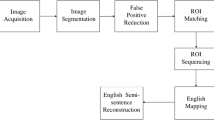Abstract
Chinese calligraphy is an oriental art. In this paper, an interactive calligraphic guiding system is first proposed to grade the score of written characters by using the image processing and the fuzzy inference techniques. The written documents are automatically segmented. Three quantized features, the center, the size and the projections of each written character, are extracted to measure the score of calligraphy. The system also gives some improving instructions for users. Some experimental results are given to show the validity and effectiveness of our proposed system. Through this useful system, users could learn and practice Chinese calligraphy at home.
Similar content being viewed by others
References
Guo B. (1995). Gate to Chinese Calligraphy. Foreign Languages Press, Beijing
Chen, Y.: Practicing your chinese calligraphy. http://www.resources.emb.gov.hk/chical/ (2006)
Tang, L., Kender, J.: A off-line stroke-based handwritten word segmentation and recognition method for low-quality educational videos. In: Proceedings of the 16th International Symposium on Multimedia Software Engineering pp. 565–568 (2004)
Han C.C., Tseng Y.L., Fan K.C., Wang A.B. (1995). Coarse classification of chinese characters via stroke clustering method. Pattern Recogn. Lett. 16(10): 1079–1089
Wen M.-G., Han C.-C., Fan K.-C., Tang D.-W. (2003). A coarse classification scheme on printed chinese characters by encoding the feature points. J. Inf. Sci. Eng. 19: 555–570
Wen M.-G., Fan K.-C., Han C.-C. (2004). Classification of chinese characters using pseudo skeleton features. J. Inf. Sci. Eng. 20: 903–922
Ko, M.-A., Kim, Y.-M.: A simple ocr method from strong perspective view. In: Proceedings of the 33th Workshop on Applied Imagery Pattern Recognition 235–240 (2004)
Wang A.B., Fan K.C., Wu W.H. (1998). Speeding up chinese character recognition in an automatic document reading system. Pattern Recogn. 31: 1601–1612
Wang A.B., Fan K.C. (2001). Optical recognition of handwritten chinese characters by hierarchical radical matching method. J. Pattern Recog. 34: 15–35
Gonzalez, R.C., Woods, R.E.: Digital Image Processing. Addison-Wesley (1992)
Otsu N. (1979). A threshold selection method from gray-level histograms. IEEE Transactions System, Man Cybern. 9: 62–66
Kittler J., Illingworth J. (1986). Minimum error thresholding. Pattern Recogn. 19: 41–47
Cho S., Haralick R.M., Yi S. (1989). Improvement of kittler and illingworth’s minimum error thresholding. Pattern Recogn. 22: 609–617
Sahoo P.K. (1988). A survey of thresholding techniques. Comput. Vis. Graph. Image Process. 41: 233–260
Lin C., Lee C.G. (1996). Neural Fuzzy Systems. Prentice-Hall, New Jersey
Jang J., Sun C., Mizutani E. (1997). Neuro-Fuzzy and Soft Computing. Prentice-Hall, New Jersey
Homnan B., Benjapolakul W. (2004). Application of fuzzy inference to CDMA soft handoff in mobile communication systems. Fuzzy Sets Systems 144: 345–363
Hong L., Sun J. (2006). Bifurcations of forced oscillators with fuzzy uncertainties by the generalized cell mapping method. Chaos Solitons Fractals 27: 895–904
Lo S. (2006). An adaptive-network based fuzzy inference system for prediction of workpiece surface roughness in end milling. J Mater. Process. Technol. 142: 665–675
Yilmaz O., Eyercioglu O., Gindy N. (2006). A user-friendly fuzzy-based system for the selection of electro discharge machining process parameters. J. Mater. Process. Technol. 172: 363–371
Mari M., Dellepiane S. (1997). A non-linear image processing approach through fuzzy measures. Pattern Recogn. Lett. 18: 1109–1115
Flaig A., Barner K.E., Arce G.R. (2000). Fuzzy ranking: theory and applications. Signal Process. 80: 1017–1036
Kim M.H., Jang D.S., Yang Y.K. (2001). A robust-invariant pattern recognition model using fuzzy ART. Pattern Recogn 34: 1685–1696
Banerjee M., Kundu M. (2003). Edge based features for content based image retrieval. Pattern Recogn. 36: 2649–2661
Li C., Huang J., Chen C. (2004). Soft computing approach to feature extraction. Fuzzy Sets Systems 147: 119–140
Yen J., Langari R. (1999). Fuzzy Logic: Intelligence, Control and Information. Prentice Hall, New Jersey
Author information
Authors and Affiliations
Corresponding author
Rights and permissions
About this article
Cite this article
Han, CC., Chou, CH. & Wu, CS. An interactive grading and learning system for chinese calligraphy. Machine Vision and Applications 19, 43–55 (2008). https://doi.org/10.1007/s00138-007-0076-0
Received:
Accepted:
Published:
Issue Date:
DOI: https://doi.org/10.1007/s00138-007-0076-0




